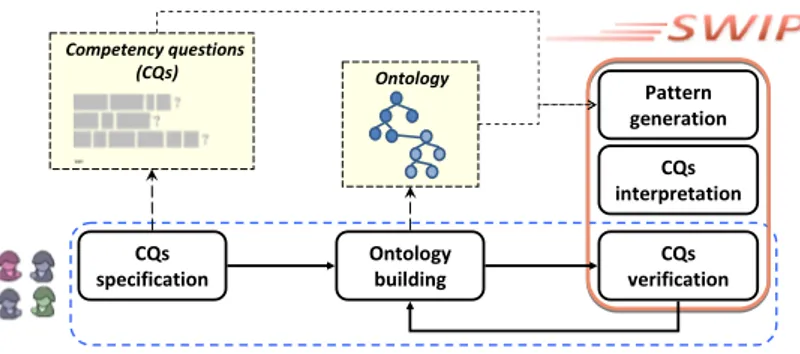HAL Id: hal-03256406
https://hal.archives-ouvertes.fr/hal-03256406
Submitted on 14 Jun 2021HAL is a multi-disciplinary open access
archive for the deposit and dissemination of sci-entific research documents, whether they are pub-lished or not. The documents may come from teaching and research institutions in France or abroad, or from public or private research centers.
L’archive ouverte pluridisciplinaire HAL, est destinée au dépôt et à la diffusion de documents scientifiques de niveau recherche, publiés ou non, émanant des établissements d’enseignement et de recherche français ou étrangers, des laboratoires publics ou privés.
Verifying ontology requirements with SWIP (Workshop
on Knowledge, Reasoning and Computation, 2014)
Maria del Carmen Suárez Figueroa, Camille Pradel, Nathalie Hernandez
To cite this version:
Maria del Carmen Suárez Figueroa, Camille Pradel, Nathalie Hernandez. Verifying ontology re-quirements with SWIP (Workshop on Knowledge, Reasoning and Computation, 2014). Workshop on Knowledge, Reasoning and Computation 2014, Apr 2014, Madrid, Spain. �hal-03256406�
Verifying Ontology Requirements with SWIP
Mari Carmen Suárez-Figueroa1, Camille Pradel2, Nathalie Hernandez2 1 Ontology Engineering Group (OEG), Facultad de Informática, Universidad Politécnica de
Madrid, Campus Montegancedo, Boadilla del Monte, Madrid, España.
2 IRIT, 118 route de Narbonne, 31063 Toulouse Cedex
mcsuarez@fi.upm.es,{pradel,hernandez}@irit.fr
Abstract. Verifying whether an ontology meets the set of established require-ments is a crucial activity in ontology engineering. In this sense, methods and tools are needed (a) to transform (semi-)automatically functional ontology re-quirements into SPARQL queries, which can serve as unit tests to verify the on-tology, and (b) to check whether the ontology fulfils the requirements. Thus, our purpose in this poster paper is to propose a query pattern-based approach to transform ontology requirements into SPARQL queries to facilitate the activity of verifying whether an ontology satisfies the set of established requirements. Keywords: Ontologies, requirements, SPARQL, natural language queries
1
Ontology Requirements
One of the key activities when developing ontologies is to identify the functional and non-functional requirements the ontology should fulfil. Guidelines for eliciting and specifying ontology requirements have been proposed in the context of the NeOn Methodology [1]. These guidelines suggest specifying functional ontology require-ments using the competency questions technique. Competency questions (CQs) were proposed in [2] and defined as questions that the ontology to be built should be able to answer. The idea behind these questions is to ensure that the ontology being devel-oped is competent enough to respond to queries that may be posed to a system that uses the ontology. Thus, CQs also act as a unit test suite for the ontology.
The activity of checking whether the developed ontology is in compliance with a set of ontology requirements is called ontology verification [1]. One approach for performing this activity is (a) to transform (semi-)automatically functional require-ments (as CQs) in SPARQL queries and (b) to check how many SPARQL queries obtain a response from the ontology.
2
Applying SWIP to verify Ontology Requirements
The goal of SWIP, standing for Semantic Web Interface Using Patterns, [3] is to pro-vide end users a means to query knowledge bases using natural language queries and thus hide the complexity of formulating a query expressed in a graph query language
such as SPARQL. The main postulate leading this work states that, in real applica-tions, the submitted queries are variations of a few typical query families. Our ap-proach differs from existing ones in the way that we propose to enhance the effective-ness and the efficiency of the query building step by using predefined query patterns which represent these query families. The use of patterns avoids exploring the ontol-ogy to link the semantic entities identified from the user query since potential rela-tions are already expressed in the patterns. The process thus benefits from the pre-established families of frequently expressed queries for which we know that real in-formation needs exist.
SWIP has been adapted in order to translate CQs into SPARQL queries. First, SWIP generates query patterns automatically by analyzing the set of CQs and the ontology being built. Then, the patterns are used to generate a SPARQL interpretation for each CQ. For each of the CQs, SWIP presents to the ontology development team the answers retrieved in the ontology. These answers should be checked by the team: in the case they are not compliant with the concerned CQ, the team should update the ontology consequently. This approach is shown in Figure 1.
Even if the checking process keeps hand driven by the ontology developer, the ac-tivity is now considerably lightened by the CQs automatic translation using the SWIP approach. A promising evaluation is being carried out with a set of CQs and an ontol-ogy about football developed in the context of the Buscamedia project1.
CQs specification Ontology building CQs interpretation CQs verification Competency questions (CQs) Ontology Pattern generation
Fig. 1. General approach
References
1. Suárez-Figueroa, M.C., Gómez-Pérez, A., Motta, E., Gangemi, A. (Eds.): Ontology Engi-neering in a Networked World, Springer, ISBN 978-3-642-24793-4. 2012.
2. Grüninger, M., Fox, M. S.: Methodology for the design and evaluation of ontologies, in IJCAI95 Workshop on Basic Ontological Issues in Knowledge Sharing, 1995.
3. Pradel C., Haemmerlé O., Hernandez N.: A Semantic Web Interface Using Patterns: The SWIP System, Graph Structures for Knowledge Representation and Reasoning - Second International Workshop, pp. 172-187, 2011.
1 This work has been partially supported by the Spanish project Buscamedia (CENIT
